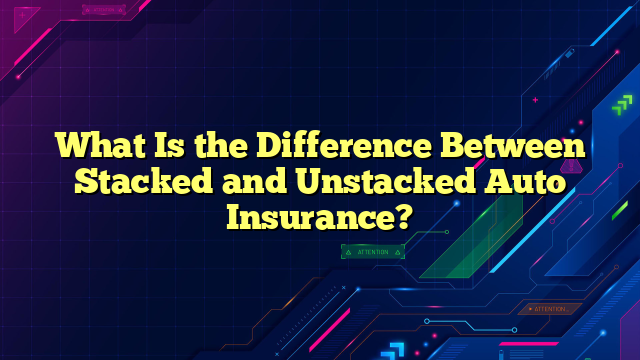Understanding the Basics of Stacked and Unstacked Auto Insurance
Hello PortalSindo Friend! Are you familiar with the terms “stacked” and “unstacked” when it comes to auto insurance? If not, don’t worry, we’ve got you covered. Let’s first define what auto insurance is. Auto insurance is a contract between you and your insurance company that protects you against financial loss in the event of an accident or theft. When it comes to auto insurance, one important consideration you need to make is whether you want stacked or unstacked coverage. Here’s what you need to know:
Defining Stacked and Unstacked Auto Insurance
Stacked auto insurance is a coverage option that allows you to combine the limits of multiple vehicles on the same policy to increase your overall coverage. Essentially, if you have more than one vehicle on your policy, stacked coverage will allow you to “stack” the coverage limits of each vehicle on top of each other. This can be beneficial if you have several vehicles or if you have one vehicle with a high value. On the other hand, unstacked auto insurance is a coverage option that provides coverage for each vehicle on your policy separately, without allowing you to combine the limits.
Pros of Stacked Auto Insurance
There are several benefits to choosing stacked auto insurance:
1. Increased Coverage Limits
Because stacked auto insurance allows you to combine the coverage limits of multiple vehicles, you can potentially have a higher overall coverage limit. This can be especially helpful if you have multiple vehicles or if you have a high-value vehicle that requires more coverage.
2. Cost Savings
In some cases, stacked auto insurance can be more cost-effective than unstacked coverage. This is because when you combine the coverage limits of multiple vehicles, you may be eligible for discounts or lower rates than if you had separate policies for each vehicle.
3. Flexibility
Stacked auto insurance provides more flexibility when it comes to choosing coverage limits. You can choose to combine the limits of all the vehicles on your policy, or you can choose to stack the limits of only certain vehicles. This can allow you to customize your coverage to meet your specific needs.
Cons of Stacked Auto Insurance
While there are several benefits to stacked auto insurance, there are also some potential drawbacks to consider:
1. Higher Premiums
Because stacked auto insurance provides more coverage, it can also come with higher premiums. This is especially true if you have several vehicles or if you have a high-value vehicle that requires more coverage.
2. More Complex Claims Process
When you have stacked auto insurance, the claims process can be more complex. This is because you will need to determine which vehicles on your policy were involved in the accident and how much coverage is available for each vehicle. This can be time-consuming and may require assistance from your insurer.
Pros of Unstacked Auto Insurance
There are also several benefits to choosing unstacked auto insurance:
1. Lower Premiums
Unstacked auto insurance tends to be less expensive than stacked coverage, especially if you have only one vehicle on your policy. This can be a good option if you’re looking to save money on your insurance premiums.
2. Simpler Claims Process
With unstacked auto insurance, the claims process is generally simpler and more straightforward. Because each vehicle on your policy has its own coverage limit, it’s easier to determine how much coverage is available for each vehicle in the event of an accident.
Cons of Unstacked Auto Insurance
However, there are also some potential drawbacks to consider when choosing unstacked auto insurance:
1. Limited Coverage
Unstacked auto insurance provides coverage for each vehicle on your policy separately, which means that your overall coverage limit may be lower than with stacked coverage. This can be a concern if you have multiple vehicles or if you have a high-value vehicle that requires more coverage.
2. Less Flexibility
With unstacked auto insurance, you have less flexibility when it comes to choosing coverage limits. Each vehicle on your policy has its own coverage limit, and you can’t combine the limits of multiple vehicles. This can make it more difficult to customize your coverage to meet your specific needs.
Comparing Stacked and Unstacked Auto Insurance: A Table
| Stacked Auto Insurance | Unstacked Auto Insurance | |
|---|---|---|
| Definition | Allows you to combine the coverage limits of multiple vehicles on the same policy to increase your overall coverage. | Provides coverage for each vehicle on your policy separately, without allowing you to combine the limits. |
| Pros | Increased coverage limits, potential cost savings, flexibility | Lower premiums, simpler claims process |
| Cons | Higher premiums, more complex claims process | Limited coverage, less flexibility |
❓ FAQs About Stacked and Unstacked Auto Insurance
1. Which is better: stacked or unstacked auto insurance?
There is no one-size-fits-all answer to this question. The right choice for you will depend on your specific needs and circumstances. It’s important to consider the pros and cons of each option before making a decision.
2. Can I switch from stacked to unstacked auto insurance (or vice versa)?
Yes, you can switch from stacked to unstacked auto insurance (or vice versa) at any time. However, it’s important to note that there may be some restrictions or fees associated with making the switch.
3. How do I know if I have stacked or unstacked auto insurance?
You can check your auto insurance policy to see whether you have stacked or unstacked coverage. If you’re unsure, you can also contact your insurance company for more information.
4. Is stacked auto insurance more expensive than unstacked coverage?
Not necessarily. The cost of stacked and unstacked auto insurance will depend on a variety of factors, including your location, driving record, and the number of vehicles on your policy.
5. Can I stack the coverage limits of vehicles that are not on the same policy?
No, you can only stack the coverage limits of vehicles that are on the same policy.
6. How do I choose the right coverage limits for my stacked or unstacked auto insurance?
This will depend on your individual needs and circumstances. You may want to consider factors such as the value of your vehicle, your driving habits, and your budget when choosing coverage limits.
7. Can I stack the coverage limits of vehicles with different types of coverage (e.g. liability and collision)?
No, you can only stack the coverage limits of vehicles with the same type of coverage.
Conclusion: Which Is Right for You?
When it comes to choosing between stacked and unstacked auto insurance, there is no one-size-fits-all answer. Both options have their pros and cons, and the right choice for you will depend on your individual needs and circumstances. Consider factors such as the number of vehicles on your policy, the value of your vehicle, and your budget when making your decision. Ultimately, the most important thing is to make sure you have adequate coverage to protect you in the event of an accident or theft.
Take Action Today!
Don’t wait until it’s too late! Take action today and make sure you have the right auto insurance coverage for your needs. Contact your insurance provider to learn more about your options and to make sure you have the coverage you need to protect yourself and your vehicle.
Disclaimer
The information in this article is for informational purposes only and should not be construed as legal or financial advice. We recommend consulting with a licensed insurance professional to discuss your specific needs and circumstances.






